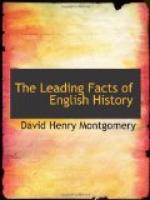448. Execution of King Charles, 1649.
This so-called “Rump Parliament” named one hundred and thiry-five persons to constitute a high court of justice to try the King on a charge of treason against the nation; the chief judge or presiding officer was John Bradshaw. Less than half of these judges were present throughout the trial. Of those who signed the death warrant Oliver Cromwell was one. Prince Charles, the King’s son, then a refugee in France, made every effort to save his father. He sent a blank paper, bearing his signature and seal, to the judges, offering to bind himself to any conditions they might insert, provided they would spare his father’s life; but no answer was returned.
The King was brought into court in Westminster Hall, London; a week later the trial was over. The judges pronounced sentence of death on “Charles Stuart, King of England,” as a “tyrant, traitor, murderer, and public enemy.”
Throughout the trial Charles bore himself with dignity and self-possession. The crisis had brought out the best elements of his nature. He was beheaded January 30, 1649, in London in front of the royal palace of Whitehall. “A great shudder ran through the crowd that saw the deed, then came a shriek, and all immediately dispersed.” Tradition declares that Cromwell went secretly that night to see the beheaded corpse. He looked steadfastly at it, shook his head, sighed out the words “Cruel necessity!” and departed.[1]
[1] S. R. Gardiner’s “Great Civil War,” III, 604; and see in Delaroche’s works the picture of Cromwell looking at the King’s corpse.
449. Summary.
The whole of Charles I’s reign must be regarded as a prolonged struggle between the King and the nation. Under the Tudors and James I the royal power had been growing more and more despotic, while at the same time the progress of the Protestant Reformation and of Puritanism had encouraged freedom of thought.
Between these opposite forces a collision was inevitable, since religious liberty always favors political liberty. Had Charles known how to yield in time, or been sincere in the concessions which he did make, all might have gone well. His duplicity was his ruin. Though his death did not absolutely destroy the theory of the Divine Right of Kings, yet it gave it a blow from which it never recovered.
The Commonwealth and Protectorate—1649-1660
450. Establishment of the Commonwealth, or Republic, 1649.
While the crowd that had witnessed the execution of Charles I was leaving the spot (S448), the remnant of the House of Commons met. This “Rump Parliament” (S447), composed of only about fifty members, claimed the right to act for the whole nation. A few days later it abolished the House of Lords as “useless and dangerous.” Next, for similar reasons, it abolished the office of king, and declared that “The People are, under God, the origin of all just power.”




